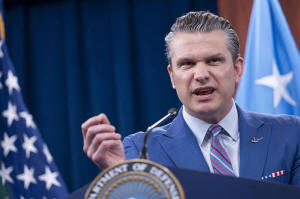Pentagon leaders cite military tactics to show destruction from US
attacks on Iran
[June 27, 2025]
By TARA COPP and LOLITA C. BALDOR
WASHINGTON (AP) — Pentagon leaders laid out new details Thursday about
military tactics and explosives to bolster their argument that U.S.
attacks had destroyed key Iranian nuclear facilities, but little more
emerged on how far back the bombing had set Tehran’s atomic program.
In a rare Pentagon news briefing, Defense Secretary Pete Hegseth and
Gen. Dan Caine, chairman of the Joint Chiefs of Staff, worked to shift
the debate from whether the nuclear targets were “obliterated,” as
President Donald Trump has said, to what they portrayed as the heroism
of the strikes as well as the extensive research and preparation that
went into carrying them out.
“You want to call it destroyed, you want to call it defeated, you want
to call it obliterated — choose your word. This was an historically
successful attack,” Hegseth said in an often combative session with
reporters.
It was the latest example of how Trump has marshaled top administration
officials to defend his claims about the effectiveness of the U.S.
strikes. At stake is the legacy of the Republican president's
intervention in the brief war between Israel and Iran, as well as the
future of American foreign policy toward Iran.
Pentagon gives little detail on status of Iran's highly enriched
uranium
Hegseth appeared less confident that the strikes got all of Iran's
highly enriched nuclear material.
Asked repeatedly whether any of it was moved to other locations before
the U.S. attack, Hegseth acknowledged that the Pentagon was “looking at
all aspects of intelligence and making sure we have a sense of what was
where."

He added, “I’m not aware of any intelligence that says things were not
where they were supposed to be” or that they were moved.
Satellite imagery showed trucks and bulldozers at Iran’s Fordo uranium
enrichment site, the main target of the bombings, days before the
strikes, which occurred between 6:40 p.m. and 7:05 p.m. EDT Saturday.
Experts said enriched uranium stocks can be moved in small canisters and
are hard to find.
“It would be extremely challenging to try and detect locations where
Iran may be hiding highly enriched uranium,” said Kelsey Davenport,
director of nonproliferation policy at the nonpartisan Arms Control
Association.
Trump expressed confidence that uranium was not pulled out before the
attack.
“Nothing was taken out of facility,” he said on social media. “Would
take too long, too dangerous, and very heavy and hard to move!”
New details emerge on how the U.S. carried out the attacks
U.S. stealth bombers dropped 12 deep penetrator bombs, called “bunker
busters,” on Fordo, Caine said. Two others hit Iran's main Natanz
facility.
Hegseth and Caine described 15 years of study and planning going into
the bombing mission and they showed video of a test explosion of a
bunker buster, designed to penetrate deep into mountains.
While Hegseth, a former Fox News anchor, spent the bulk of his time
slamming the media coverage and personally insulting reporters who
questioned him, Caine stuck to the military details of the bombing.
Caine said the U.S. targeted the ventilation shafts at the Fordo
facility as the entry point for the bombs. In the days before the U.S.
attack, the Iranians placed large concrete slabs on top of both
ventilation routes from the underground facilities to try to protect
them, he said.
[to top of second column]
|

Defense Secretary Pete Hegseth speaks during a news conference at
the Pentagon, Thursday, June 26, 2025 in Washington. (AP Photo/Kevin
Wolf)

He said six bombs were available for each of the two shafts that
were hit. The first bomb was used to eliminate the concrete slab,
then four more were dropped at slightly different angles to take out
various parts of the underground facility.
The sixth was a failsafe in case any of the others didn’t work, and
it also was dropped, Caine said.
He noted it is not his job to do the assessment of the damage. Asked
if he has been pressured to provide a more optimistic view of the
results, Caine said no.
“I’ve never been pressured by the president or the secretary to do
anything other than tell them exactly what I’m thinking. And that’s
exactly what I’ve done,” he said.
Caine also lauded the troops who remained at Al Udeid Air Base in
Qatar when the Iran launched its counterattack Monday. He said just
44 soldiers stayed to operate the two Patriot missile batteries and
protect the entire air base.
“You know that you’re going to have approximately two minutes, 120
seconds, to either succeed or fail,” Caine said, adding, “They
absolutely crushed it.”
Hegseth dismisses initial assessment from the Pentagon’s own
intelligence agency
Hegseth repeated assertions that an early assessment from the
Defense Intelligence Agency, a part of the Defense Department, was
preliminary and that the report acknowledged there was low
confidence and gaps in information.
Hegseth repeatedly scolded reporters for “breathlessly” focusing on
that assessment and said such stories were just attempts to
undermine Trump.
That report said that while the U.S. strikes on three Iranian
nuclear facilities did significant damage, the sites were not
totally destroyed and Tehran's program was only set back by a few
months.
Hegseth and others have not disputed the contents of the DIA report
but have focused on a CIA statement and other intelligence
assessments, including those out of Iran and Israel, that said the
strikes severely damaged the nuclear sites and rendered the
enrichment facility inoperable.

The International Atomic Energy Agency is not able to assess the
exact degree of damage but the centrifuges at Fordo are “no longer
operational,” the U.N. nuclear watchdog's chief, Rafael Grossi, told
French broadcaster RFI on Thursday. He said the power of the blasts
causes vibrations that would destroy any centrifuges there.
Trump appeared buoyed by Hegseth’s fierce display of loyalty and his
repeated attacks on news organizations during the briefing. The
president said on social media that it was "one of the greatest,
most professional, and most ‘confirming’ News Conferences I have
ever seen!”
___
Associated Press writers Eric Tucker, Chris Megerian and Ellen
Knickmeyer contributed to this report.
All contents © copyright 2025 Associated Press. All rights reserved |